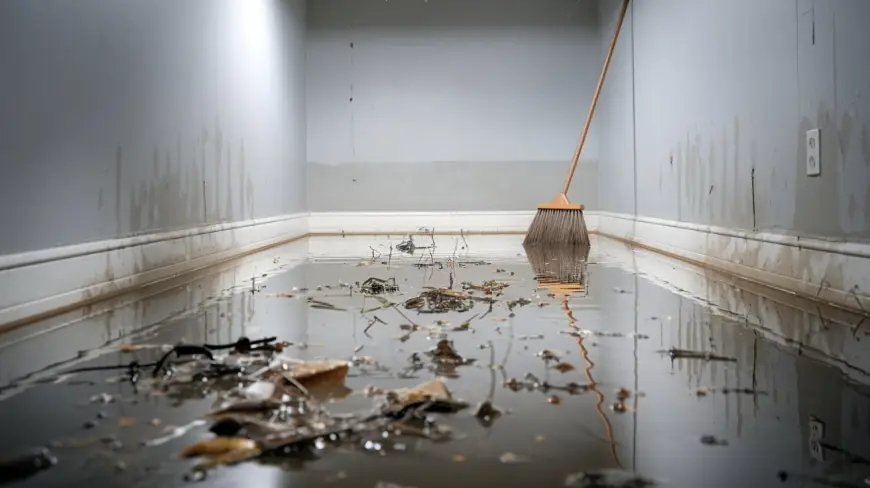Health Risks from a Sewage Backup in Basement Water
Discover the serious health risks from a sewage backup in basement water and how to protect your home and family from hidden hazards.

A sewage backup in basement areas isn’t just a plumbing emergency, it’s a serious health hazard. When raw sewage seeps into your home, it brings with it more than a foul odor and property damage. It introduces a cocktail of bacteria, viruses, parasites, and toxic gases that can pose significant health risks to you and your family.
While many homeowners focus on cleanup logistics, understanding the actual health dangers of sewage exposure is equally, if not more, important. Knowing what you're dealing with helps you take the right precautions, respond quickly, and protect the people who matter most.
What’s Actually in Sewage?
The Unseen Danger
When people think of sewage, they often picture dirty water and waste. But what makes it so dangerous is what you can’t see. Sewage is classified as “black water,” meaning it contains pathogens that can cause severe illness upon contact or inhalation.
Common Pathogens Found in Sewage
-
Bacteria: E. coli, Salmonella, Shigella
-
Viruses: Norovirus, Hepatitis A, Rotavirus
-
Parasites: Giardia, Cryptosporidium
-
Fungi & Molds: Thrive in damp environments left after a backup
-
Toxic gases: Methane, ammonia, hydrogen sulfide
Exposure to these organisms, even in small amounts, can trigger infections, respiratory issues, and long-term health problems.
How Exposure Happens in Basement Backups
More Than Just Direct Contact
A sewage backup in basement areas creates multiple avenues for health exposure. Many people assume danger only comes from stepping into contaminated water. In reality, exposure can occur:
-
By touching contaminated surfaces
-
Through inhalation of toxic or aerosolized particles
-
By eating or drinking after touching contaminated hands
-
From cuts or wounds coming in contact with sewage water
-
Through cross-contamination with clothes, tools, or furniture
The risk is highest in enclosed, poorly ventilated areas, exactly the environment most basements offer.
Key Health Risks from Basement Sewage Water
1. Gastrointestinal Infections
How They Spread
Pathogens like E. coli, Norovirus, and Salmonella can be ingested even from microscopic contact, think rubbing your eyes or eating a snack after exposure.
Symptoms
-
Vomiting
-
Diarrhea
-
Stomach cramps
-
Fever
These infections can become severe in young children, the elderly, or anyone with a weakened immune system.
2. Respiratory Issues
Airborne Threats
Hydrogen sulfide and ammonia, both present in sewage gas, can cause serious irritation or respiratory distress when inhaled.
Symptoms
-
Coughing
-
Shortness of breath
-
Dizziness
-
Burning sensation in nose or throat
Mold spores growing after a backup can also worsen asthma and trigger allergies, even weeks later.
3. Skin and Soft Tissue Infections
Direct Contact Risks
Cuts, scrapes, or even small abrasions can become entry points for dangerous bacteria like Staphylococcus aureus or Pseudomonas.
Symptoms
-
Redness and swelling
-
Blisters or oozing sores
-
Cellulitis
-
Fever or chills in advanced infections
In rare but serious cases, sewage-borne bacteria can lead to necrotizing fasciitis, commonly known as “flesh-eating disease.”
4. Hepatitis A
A Serious Viral Infection
This highly contagious virus spreads through fecal-oral contact and is frequently found in raw sewage.
Symptoms
-
Fatigue
-
Jaundice (yellowing of the skin and eyes)
-
Loss of appetite
-
Dark urine
While not typically fatal, hepatitis A can cause long-term liver complications and demands medical attention.
5. Leptospirosis
A Lesser-Known Risk
This bacterial infection is transmitted through contact with contaminated water, especially if it enters through mucous membranes or broken skin.
Symptoms
-
High fever
-
Muscle aches
-
Vomiting
-
Red eyes
-
In severe cases: kidney damage or meningitis
Outbreaks of leptospirosis often follow flooding and sewer overflows, making it a concern during severe backups.
Who’s Most at Risk?
While anyone can be affected by a sewage backup in basement conditions, certain groups face heightened danger:
Vulnerable Populations
-
Children: More likely to touch contaminated surfaces and put hands in mouths
-
Elderly individuals: Weaker immune systems and slower recovery times
-
Immunocompromised people: At greater risk for infections and complications
-
Pregnant women: Some pathogens can cause harm to the fetus
-
Pets: Dogs and cats may drink or play in contaminated water without restraint
Special care should be taken to protect these individuals, and to restrict access to affected areas until full sanitation is completed.
Safe Cleanup Practices to Minimize Health Risk
Personal Protective Equipment (PPE)
Before entering a contaminated basement, always wear:
-
Rubber gloves
-
Waterproof boots
-
Long pants and sleeves
-
Eye protection
-
Respirator or N95 mask
Never underestimate the level of exposure, even brief contact can lead to infection.
Ventilate the Space
Open windows and use fans to move contaminated air outside. If natural ventilation is impossible, consider portable air scrubbers with HEPA filters.
Disinfect, Don’t Just Clean
Soap and water remove dirt, but disinfection is what kills pathogens.
Use:
-
Bleach solution (1 part bleach to 10 parts water)
-
EPA-registered disinfectants
-
Steam cleaning for non-porous items (if salvageable)
Avoid mixing cleaning agents (e.g., bleach and ammonia), which can produce toxic fumes.
Discard Contaminated Materials
Anything porous, carpets, drywall, paper, soft furniture, should be discarded. These materials trap contaminants and cannot be reliably disinfected.
Post-Cleanup Health Precautions
After cleaning:
-
Wash hands thoroughly
-
Shower and change clothes immediately
-
Launder contaminated clothing separately
-
Monitor your health for any unusual symptoms over the next 7–10 days
When to Call Professionals
Not every sewage incident can or should be handled alone. Contact a licensed cleanup service if:
-
The affected area is larger than 10 square feet
-
Water has been standing for over 24 hours
-
Mold is already visible
-
You lack proper PPE or training
-
Vulnerable individuals live in the home
These professionals have access to commercial-grade disinfectants, extraction equipment, and the expertise to restore your home safely.
Preventing Future Sewage Exposures
You can reduce your risk of future health threats by addressing the root causes of sewage backup in basement problems.
Prevention Tips
-
Install a backwater valve to block reverse sewage flow
-
Schedule sewer line inspections every 2–3 years
-
Avoid flushing anything but toilet paper
-
Dispose of cooking grease in the trash, not the sink
-
Maintain gutters and yard drainage to keep stormwater away from your foundation
These small steps not only protect your plumbing, they protect your health.
Final Thoughts
A sewage backup in basement areas is more than a home maintenance headache, it’s a public health concern that hits too close to home. The water that floods your basement may be invisible in its danger, but its effects can linger long after the mess is cleaned up.
Recognizing the risks, protecting your health, and knowing when to call in professionals can make all the difference. Because at the end of the day, safety isn’t just about dry floors, it’s about the people who walk on them.
What's Your Reaction?
 Like
0
Like
0
 Dislike
0
Dislike
0
 Love
0
Love
0
 Funny
0
Funny
0
 Angry
0
Angry
0
 Sad
0
Sad
0
 Wow
0
Wow
0
















































